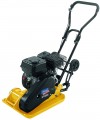Vibration frequency
The frequency of movements made by the sole of the tool in normal operation. For different materials, the optimal vibration frequency may also be different; specific recommendations can be found in special sources. It should be noted that classical vibrating plates (see "Type") have a rather high frequency of operation — from 3700 beats / min and above, but in vibrating rammers this figure is much lower and rarely exceeds 700 beats / min; such differences are due to differences in the way they work.
Sole length
The length of the sole — the working surface of the sole. The sole area depends on the length and width (see below) — that is, the space captured by the vibrating plate without moving from its place. Larger soles are comfortable for large volumes of work in wide spaces, while more compact ones perform better in tight spaces and apply more pressure (all other things being equal).
Sole width
The width of the working surface of the vibrating plate. The area of the sole depends on the length and width, respectively, its suitability for processing large spaces. Specifically, the width determines, on the one hand, the size of the strip captured in one pass, on the other hand, the passability of the unit. So, for open spaces, wide soles will be convenient, they will allow you to cope with the processing in fewer passes; but when working in narrow places, the width should be small, otherwise the vibrating plate may simply not fit in the right place.
Engine size
The working volume of the internal combustion engine installed in the vibrating plate. The power of the unit and fuel consumption directly depend on this indicator. At the same time, manufacturers usually choose the volume in such a way as to provide the necessary power; therefore, this parameter in fact is secondary, and when choosing, it makes sense to focus more on power, and not on volume.
Fuel tank volume
Nominal volume of the fuel tank of a vibrating plate with an internal combustion engine (see “Engine type”), in other words, the amount of fuel that the unit can carry with it. Knowing this indicator, as well as fuel consumption (see below), you can determine the time of continuous operation on a single refill — by dividing the tank capacity by the consumption. At the same time, we note that it is usually more convenient to regularly refuel a relatively small tank than to carry a large (and, accordingly, heavy) supply of fuel with you. With this calculation, manufacturers choose the volume of the fuel tank — so that the vibrating plate does not have to be refilled too often and at the same time so that the fuel tank does not greatly affect the dimensions and weight.
Weight
The total weight of the vibrating plate. For models with internal combustion engines (see "Engine type") it is indicated without taking into account the fuel in the tank; however, the weight of the fuel compared to the weight of the unit itself is usually very small, and this difference can be neglected.
Weight directly affects the impact force that the unit can provide, and, as a result, the purpose and use of the tool. So, in the case of classic vibrating plates (see "Type"), an indicator of up to 75 kg corresponds to light weight, such a tool is designed mainly for loose materials (sand, soil, fine gravel) and a small compaction depth (up to 15 cm). An indicator of 75 – 90 kg allows you to achieve a depth of up to 25 cm, such models can already be used not only in landscape work, but also when laying asphalt. A weight of 90 – 140 kg corresponds to the average level, the purpose of most of these models is road work and general construction. Professional equipment has a weight of 150 kg, it can be used for almost any material and even used as a replacement for road rollers, however, and costs accordingly.
In turn, the weight of vibratory rammers is usually in the range of 60 – 90 kg, and vibrating screeds weigh even less — usually less than 25 kg.

